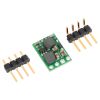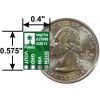Pololu 12V Step-Up/Step-Down Voltage Regulator S10V2F12
Retired Product
Replaced by: POLOLU-2577This product is no longer available. This page is only for reference.
 |
The Pololu step-up/step-down voltage regulator S10V2F12 is a switching regulator (also called a switched-mode power supply (SMPS) or DC-to-DC converter) with a single-ended primary-inductor converter (SEPIC) topology. It takes an input voltage from 2.5 V to 18 V and increases or decreases the voltage to a fixed 12 V output with a typical efficiency of 70% to 80%.
This flexibility in input voltage is especially well-suited for battery-powered applications in which the battery voltage begins above 12 V and drops below as the battery discharges. Since it lacks the typical restriction that the battery voltage stay above the required voltage throughout its life, new battery packs and form factors can be considered.
In typical applications, this regulator can deliver over 200 mA continuous; please see the graphs at the bottom of this page for a more detailed characterization. The regulator’s thermal shutdown prevents damage from overheating, but it does not have short-circuit or reverse-voltage protection.
 |
 |
This regulator is also available with a fixed 5 V output or a fixed 9 V output.
Features
- Input voltage: 2.5 V to 18 V (can be higher than, the same as, or lower than the 12 V output)
- Fixed 12 V output with 4% accuracy
- Typical continuous output current: 200 mA (actual continuous output current depends on input voltage; see Typical Efficiency and Output Current section below for details)
- <2 mA typical no-load quiescent current
- Integrated over-temperature shutoff
- Small size: 0.40" × 0.575" × 0.1" (10 mm × 15 mm × 3 mm)
Using the Regulator
This regulator can be permanently damaged when pushed beyond its upper limits; make sure the output current does not exceed 200 mA for applications where the input voltage can approach the 18 V limit.
During normal operation, this product can get hot enough to burn you. Take care when handling this product or other components connected to it.
Connections
This step-up/step-down regulator has four connections: shutdown (SHDN), input voltage (VIN), ground (GND), and output voltage (VOUT).
The SHDN pin can be driven low (under 0.4 V) to power down the regulator. The quiescent current in this shutdown mode is dominated by the current in the 10 kO pull-up resistor from SHDN to VIN. With SHDN held low, this resistor will draw 0.1 mA per volt on VIN (for example, the shutdown current with a 5 V input will be 0.5 mA). This pin should only ever be driven low or left floating; this can be accomplished with a physical switch that toggles it between ground and disconnected, or electrically with something like a transistor controlled by an I/O line.
The input voltage should be between 2.5 V and 18 V. Lower inputs can shut down the voltage regulator; higher inputs can destroy the regulator, so you should ensure that noise on your input is not excessive and be wary of destructive LC spikes (see below for more information).
The four connections are labeled on the back side of the PCB, and they are arranged with a 0.1" spacing along the edge of the board for compatibility with standard solderless breadboards and perfboards and connectors that use a 0.1" grid. You can solder wires directly to the board or solder in either the 4×1 straight male header strip or the 4×1 right-angle male header strip that is included.
 |
Typical Efficiency and Output Current
The efficiency of a voltage regulator, defined as (Power out)/(Power in), is an important measure of its performance, especially when battery life or heat are concerns. As shown in the graphs below, this switching regulator typically has an efficiency of 70% to 80%.
The maximum achievable output current of the board varies with the input voltage but also depends on other factors, including the ambient temperature, air flow, and heat sinking. The graph below shows output currents at which this voltage regulator’s over-temperature protection typically kicks in after a few seconds. These currents represent the limit of the regulator’s capability and cannot be sustained for long periods, so the continuous currents that the regulator can provide are typically lower.
 |
LC Voltage Spikes
When connecting voltage to electronic circuits, the initial rush of current can cause voltage spikes that are much higher than the input voltage. If these spikes exceed the regulator’s maximum voltage, the regulator can be destroyed. In Pololu's tests with typical power leads (~30" test clips), input voltages above 11 V caused spikes over 18 V. You can suppress such spikes by soldering a 33 µF or larger electrolytic capacitor close to the regulator between VIN and GND.
More information about LC spikes can be found in Pololu's application note, Understanding Destructive LC Voltage Spikes.
People often buy this product together with:
 | Pololu 5V, 500mA Step-Down Voltage Regulator D24V5F5 |
 | Pololu 12V Step-Up/Step-Down Voltage Regulator S18V20F12 |
 | Pololu 5V, 600mA Step-Down Voltage Regulator D24V6F5 |
Dimensions
| Size: | 0.4" × 0.575" × 0.1"1 |
|---|---|
| Weight: | 0.6 g1 |
General specifications
| Minimum operating voltage: | 2.5 V |
|---|---|
| Maximum operating voltage: | 18 V |
| Maximum output current: | 200 mA2 |
| Output voltage: | 12 V |
| Reverse voltage protection?: | N |
| Maximum quiescent current: | 2 mA3 |
Identifying markings
| PCB dev codes: | reg11a |
|---|---|
| Other PCB markings: | 0J7068 |
Notes:
- 1
- Without included optional headers.
- 2
- Typical maximum that can be delivered continuously without overheating. Actual maximum output current depends on input voltage.
- 3
- While enabled (SHDN floating) with no load. Actual quiescent current depends on input voltage.
File downloads
-
Dimension diagram of the Pololu Step-Up/Step-Down Voltage Regulator S10V4F5, S10V3F9, and S10V2F12 (215k pdf)
-
3D model of the Pololu Step-Up/Step-Down Voltage Regulator S10V4F5, S10V3F9, and S10V2F12 (3MB step)
-
Drill guide for Pololu Step-Up/Step-Down Voltage Regulator S10V4F5, S10V3F9, and S10V2F12 (18k dxf)
This DXF drawing shows the locations of all of the board’s holes.
Exact shipping can be calculated on the view cart page (no login required).
Products that weigh more than 0.5 KG may cost more than what's shown (for example, test equipment, machines, >500mL liquids, etc).
We deliver Australia-wide with these options (depends on the final destination - you can get a quote on the view cart page):
- $3+ for Stamped Mail (typically 10+ business days, not tracked, only available on selected small items)
- $6+ for Standard Post (typically 6+ business days, tracked)
- $10+ for Express Post (typically 2+ business days, tracked)
- Pickup - Free! Only available to customers who live in the Newcastle region (must order online and only pickup after we email to notify you the order is ready). Orders placed after 2PM may not be ready until the following business day.
Non-metro addresses in WA, NT, SA & TAS can take 2+ days in addition to the above information.
Some batteries (such as LiPo) can't be shipped by Air. During checkout, Express Post and International Methods will not be an option if you have that type of battery in your shopping cart.
International Orders - the following rates are for New Zealand and will vary for other countries:
- $11+ for Pack and Track (3+ days, tracked)
- $16+ for Express International (2-5 days, tracked)
If you order lots of gear, the postage amount will increase based on the weight of your order.
Our physical address (here's a PDF which includes other key business details):
Unit 18, 132 Garden Grove Parade
Adamstown
NSW, 2289
Australia
Take a look at our customer service page if you have other questions such as "do we do purchase orders" (yes!) or "are prices GST inclusive" (yes they are!). We're here to help - get in touch with us to talk shop.
Have a product question? We're here to help!
Guides
The Maker Revolution
Projects
Accurate IoT Clock With ESP8266
Days2Bin: Pico Powered Bin Reminder
Raspberry Pi Video Looper Display Installation | Overshare Video Festival
Makers love reviews as much as you do, please follow this link to review the products you have purchased.












Product Comments